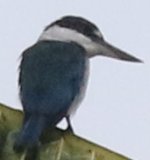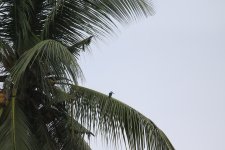Folks
I took this on 13/7/2023 at Tangkoko in an open area away from the coast. I'm at a loss to know how one might distinguish Talaud from Collared Kingfisher—all the characters mentioned here:
The taxonomic status of Halcyon enigma on the Talaud islands, Indonesia
seem exhibited by both "species", for example. I suspect my image might be Talaud as:
(Ultimately I'm with @James Eaton in regarding this taxon as dubious, but hey it's a "tick")
On a separate note: can pygmy hanging parrot, Loriculus exilis, ever exhibit a dark bill? I assume "no".. (but standard references get key characters wrong so I thought I'd ask)?
Thanks for looking...
I took this on 13/7/2023 at Tangkoko in an open area away from the coast. I'm at a loss to know how one might distinguish Talaud from Collared Kingfisher—all the characters mentioned here:
The taxonomic status of Halcyon enigma on the Talaud islands, Indonesia
seem exhibited by both "species", for example. I suspect my image might be Talaud as:
- bill seems "short", compact and not as deep as Collared generally is
- pale of lower mandible is somewhat restricted, extends less than halfway along (this character seems to vary in both taxa, but Collared often seem to have more extensive pale)
- There's a greenish sheen to the back (present but not especially obvious in the photo)

(Ultimately I'm with @James Eaton in regarding this taxon as dubious, but hey it's a "tick")
On a separate note: can pygmy hanging parrot, Loriculus exilis, ever exhibit a dark bill? I assume "no".. (but standard references get key characters wrong so I thought I'd ask)?
Thanks for looking...
Attachments
Last edited:





